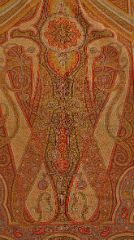Paisley shawls

The original shawls were brought back to Europe from Kashmir in the 18th century. The shawls were originally worn by men and were oblong and plain in the centre with the teardrop motif at the ends. The origin of the iconic Paisley motif is the Babylonian tree of life, which features quite extensively in Middle Eastern design. Given the high cost of the shawls, weavers started creating copies of the shawls, beginning in Edinburgh in 1767. The industry was focused around the West Port and Sciennes. By 1810 there were over 100 weavers creating Kashmir inspired shawls in Edinburgh. Other industries developed in Norwich and France.
In 1808 Edinburgh weavers outsourced production to Paisley where new jacquard looms which made it easier to weave complex designs were introduced. By the 1830s production in Paisley outstripped the other areas of Britain - the last Edinburgh shawl was produced in 1847 - to such an extent that the shawls became known as "Paisleys". Fashion changed in the 1870s, with bustles replacing crinolines, which meant that shawls went out of fashion very quickly.
Shawl shape and design varied quite extensively. Early shawls were narrow and oblong with simple designs. Later shawls were larger with more ornate allover patterns. The collection includes over 120 shawls from the early 19th century to the 1850s. The shawls are available for consultation but we need advanced notice as two people are required to produce them. Images are available through our on-line catalogue and Shoogleit.
Key information
Helen Taylor
- Archivist
- h.e.taylor@hw.ac.uk
Museum and Archive Service
- +44 (0) 131 451 3218
- heritage@hw.ac.uk